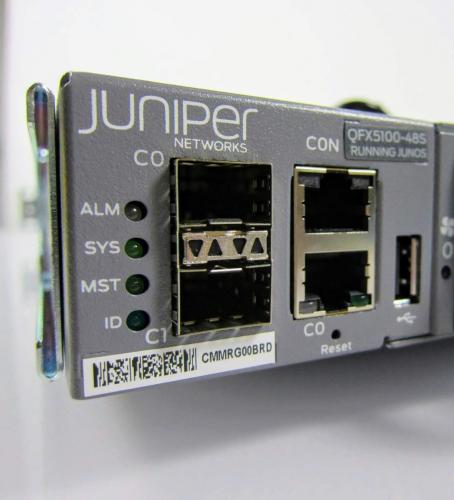Deep Dive into the Juniper QFX5100 Switch
The Juniper QFX5100 switches are in high demand recently. We’ve been moving many QFX5100-48T, QFX5100-48S (as well as some QFX10002), and we keep getting asked for more. Why so much action? Here is a deep dive on what makes them such a valuable part of our clients’ networks.
Utilizing a dual core x86 CPU and the Broadcom Trident II chipset, the QFX5100 is an all-purpose switch, great for spine and leaf architecture, virtual chassis, or top of rack implementations. The QFX is slim, fast, and more affordable than ever.
Speeds and feeds include:
- Up to 2.56 Tbps Layer 2 and Layer 3 performance
- 550ns latency
- 1U or 2U unit
The virtual chassis (VC) set these units apart from their competitors letting you sail through a stack setup. Using VC can create a single control point from which you can command up to ten QFX5100 switches while still including legacy QFX3500 and QFX3600 devices in the overall VC.
With Juniper Virtual Chassis Fabric (VCF), you can even include the EX4300 in the VCF with up to 20 total switches run by one management node. And utilizing the Topology-Independent In-Service Software Upgrade (TISSU) built-in to JunOS, you can update the software on a ten-unit fabric of QFX units in just a few minutes, no downtime. Automation and ease of management is where Juniper excels in the marketplace, and the QFX5100 is where those features shine.
If, on the other hand, you want to control each node yourself, the 40G QSFP ports on the QFX5100 units are a perfect way to set up a MC LAG for a topology that has 80GB of throughput between switches with a loop-free Layer 2 network, no spanning-tree worries. No single point of control failure except for the administrator. That puts you in charge of a lightning fast L2 network.
Juniper has also been a leader in implementing VXLAN with their QFX switches, racing ahead of their competitors by taking this fairly new form of LAN configuration and increasing the capacity for local area networks. It’s a rock-solid way to turn the tired old limits of a 4096 VLAN capability into millions of VLANS using MAC-in-UDP encapsulation. (Important to note: for VXLAN to work, you’re going to have to have an apples to apples network, all QFX5100s in the VCF, no legacy EX stragglers). Cisco has done a great job catching up with their NX-OS, but Juniper dove in first for a reason, and remains in the lead with their feature-rich QFX switches.
Configuring those features are a little different with Juniper’s new ELS CLI, a modified JunOS that allows you to run a range of L2/L3 implementations within the same OS framework. If you’re getting your feet wet with one of these for the first time, it’s good to familiarize yourself with the ELS CLI ahead of time.
Juniper’s really got a great switch in the QFX5100. Great innovation, great feature sets (check the website for newer and newer implementations of cutting edge tech), and stable, fast hardware.
Connect with us via email, chat live, or pick up the phone and call us at +1 (415) 230-4353.
The Power of Threes
You'll notice that there are two part numbers for every QFX switch, with a mysterious "3" included on some models (e.g., QFX5100-48S-AFO and QFX5100-48S-3AFO). That extra number just means that there are two management ports on the "3" models, allowing for you to have two different out-of-band links to the same switch for added redundancy in your network. If you feel the need for that security blanket, the cost difference is negligible.

